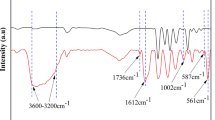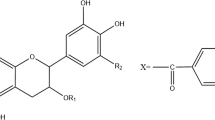Abstract
Polyvinylidene fluoride (PVDF) membranes were surface modified via a simple coating method for improvement of the hydrophilicity performance. In this work, a hydrophilic modified TA/PVDF membrane was prepared by depositing tannic acid (TA). Then, Ethylenediamine (ED) and succinic acid (SA) were grafted onto the surface of the TA coating to prepare TA/ED/PVDF and TA/ED/SA/PVDF membranes. The surface chemical compositions of the modified membrane were investigated by Fourier transform infrared and X-ray photoelectron spectroscopy, and the surface topography of the modified membrane was studied using scanning electron microscopy and atomic force microscopy. Compared with the pristine membrane, the modified membrane has good hydrophilicity and permeability. The water contact angle and water flux of TA/ED/SA/PVDF membrane are 43.3° and 143.8 L·m−2·h−1, respectively. When TA/ED/SA/PVDF membrane was used to separate (Bisphenol A) BPA and (Tetracycline) TC, the rejection ratios reached 86.3% and 91.7%. In addition, the influence of membrane surface charge on the rejection ratio of TC solution was discussed. The results showed that by increasing the pH of the solution from 4 to 10, the retention ratio of TA/ED/SA/PVDF membrane for TC solution increased from 88.8 to 94.4%. In the cycle test, the TA/ED/SA/PVDF membrane has good antifouling performance after three cycles, and its Flux recovery rate reached 89.9%. These results indicated a great application potential of the TA/ED/SA/PVDF modified membrane for water purification, especially antibiotics wastewater treatment.














Similar content being viewed by others
References
Burton FL, Stensel HD, Tchobanoglous G et al (2003) Wastewater engineering: treatment and reuse. McGraw-Hill Ser Water Resour Environ Eng 73:50–51
Hashino M, Katagiri T, Kubota N, Ohmukai Y, Maruyama T, Matsuyama H (2011) Effect of surface roughness of hollow fiber membranes with gear-shaped structure on membrane fouling by sodium alginate. J Membr Sci 366:389–397
Wang Z, Zhang P, Hu F, Zhao Y, Zhu L (2017) A crosslinked b-cyclodextrin polymer used for rapid removal of a broadspectrum of organic micropollutants from water. Carbohyd Polym 177:224–231
Shannon MA, Bohn PW, Elimelech M, Georgiadis JG, Marinas BJ, Mayes AM (2008) Science and technology for water purification in the coming decades. Nature 452:301–310
Sui Y, Wang Z, Gao X et al (2012) Antifouling PVDF ultrafiltration membranes incorporating PVDF-g-PHEMA additive via atom transfer radical graft polymerizations. J Membr Sci 38:413414
Wu H, Mansouri J, Chen V (2013) Silica nanoparticles as carriers of antifouling ligands for PVDF ultrafiltration membranes. J Membr Sci 433:135–151
Kang GD, Cao YM (2014) Application and modification of poly(vinylidene fluoride) (PVDF) membranes: a review. J Membr Sci 463:145–165
Wu X, Zhao B, Wang L et al (2016) Hydrophobic PVDF/graphene hybrid membrane for CO2, absorption in membrane contactor. J Membr Sci 520:120–129
Liu J, Shen X, Zhao Y, Chen L (2013) Acryloylmorpholinegrafted PVDF membrane with improved protein fouling resistance. Ind Eng Chem Res 52:18392–18400
Cui A, Zhen L, Xiao C et al (2010) Effect of micro-sized SiO2-particle on the performance of PVDF blend membranes via TIPS. J Membr Sci 360(1):259–264
Kaur S, Ma Z, Gopal R et al (2007) Plasma-induced graft copolymerization of poly(methacrylic acid) on electrospun poly(vinylidene fluoride) nanofiber membrane. Langmuir 23(26):13085–13092
Zuo JH, Cheng P, Chen XF et al (2018) Ultrahigh flux of polydopamine-coated PVDF membranes quenched in air via thermally induced phase separation for oil/water emulsion separation. Sep Purif Technol 192:348–359
Zhang W, Shi Z, Zhang F, Liu X, Jin J, Jiang L (2013) Superhydrophobic and superoleophilic PVDF membranes for effective separation of water-in-oil emulsions with high flux. Adv Mater 25:2071–2076
Annamalai J, Nallamuthu T (2015) Characterization of biosynthesized gold nanoparticles from aqueous extract of chlorella vulgaris and their anti-pathogenic properties. Appl Nanosci 5:603–607
Mujeeb Rahman P, Abdul Mujeeb VM, Muraleedharan K (2017) Chitosan–green tea extract powder composite pouches for extending the shelf life of raw meat. Polym Bull 74:3399–3419
Drynan JW, Clifford MN, Obuchowicz J et al (2010) The chemistry of low molecular weight black tea polyphenols. Nat Prod Rep 27(3):417–462
Gulcin I, Huyut Z, Elmastas M, Aboul-Enein HY (2010) Radical scavenging and antioxidant activity of tannic acid. Arabian J Chem 3:43–53
Sileika TS, Barrett DG, Zhang R, Lau HKA, Messersmith PB (2013) Colorless multifunctional coatings inspired by polyphenols found in tea, chocolate, and wine. Angew Chem Int Ed 52:10766–10770
Lee H, Dellatore SM, Miller WM, Messersmith PB (2007) Mussel-inspired surface chemistry for multifunctional coatings. Science 318:426–430
Liu YF, Bai ZX, Lin G et al (2022) Tannic acid-mediated interfacial layer-by-layer self-assembly of nanofiltration membranes for high-efficient dye separation. Appl Surface Sci 602:154264
Li SH, Meng HN, Wang HH et al (2022) A sacrificial protective layer as fouling control strategy for nanofiltration in water treatment. Water Res 219:118554
Lim MY, Choi YS, Kim J et al (2017) Cross-linked graphene oxide membrane having high ion selectivity and antibacterial activity prepared using tannic acid-functionalized graphene oxide and polyethyleneimine. J Membr Sci 521:1–9
Cui Z, Hassankiadeh NT, Lee SY et al (2013) Poly(vinylidene fluoride) membrane preparation with an environmental diluent via thermally induced phase separation. J Membr Sci 444(1):223–236
Chakrabarty T, L Pe´rez-Manrı´quez, Neelakanda P, Peinemann KV (2017) Bioinspired tannic acid-copper complexes as selective coating for nanofiltration membranes. Sep Purif Technol 184:188–194
Zhang R, Liu Y, Li Y et al (2021) Preparation of polyvinylidene fluoride modified membrane by tannin and halloysite nanotubes for dyes and antibiotics removal. J Mater Sci 56:10218–10230. https://doi.org/10.1007/s10853-021-05911-4
Cui Z, Hassankiadeh NT, Lee SY, Lee JM, Woo KT, Sanguineti A (2013) Poly(vinylidene fluoride) membrane preparation with an environmental diluent via thermally induced phase separation. J Membr Sci 444:223–236
Madaeni SS, Zinadini S, Vatanpour V (2013) Preparation of superhydrophobic nanofiltration membrane by embedding multiwalled carbon nanotube and polydimethylsiloxane in pores of microfiltration membrane. Sep Purif Technol 111:98–107
Wang KY, Chung TS, Gryta M (2008) Hydrophobic PVDF hollow fiber membranes with narrow pore size distribution and ultra-thin skin for the fresh water production through membrane distillation. Chem Eng Sci 63:2587–2594
Teyssedre G, Bernes A, Lacabanne C (2010) Influence of the crystalline phase on the molecular mobility of PVDF. J Polym Sci Part B Polym Phys 31(13):2027–2034
Yongho J, Yangjun J, Sang Uck L et al (2016) Aggregation and stabilizationof carboxylic acid functionalizedhalloysite nanotubes (HNT-COOH). J Phys Chem C 116:18230–18235
Yang HC, Wu MB, Li YJ et al (2016) Effects of polyethyleneimine molecular weight and proportion on the membrane hydrophilization by codepositing with dopamine. J Appl Polym Sci 133(32):265–274
Luo H, Gu C, Zheng W, Dai F, Wang X, Zheng Z (2015) Facile synthesis of novel size-controlled antibacterial hybrid spheres using silver nanoparticles loaded with poly-dopamine spheres. RSC Adv 5:13470–13477
Dreyer DR, Miller DJ, Freeman BD, Paul DR, Bielawski CW (2013) Perspectives on poly (dopamine). Chem Sci 4:3796–3802
Hegab HM, Elmekawy A, Barclay TG, Michelmore A, Zou L, Saint CP (2016) Single-step assembly of multifunctional poly (tannic acid)-graphene oxide coating to reduce biofouling of forward osmosis membranes. Acs Appl Mater Inter 8:17519–17528
Kim JH, Park PK, Lee CH et al (2008) Surface modification of nanofiltration membranes to improve the removal of organic micro-pollutants (EDCs and PhACs) in drinking water treatment: graft polymerization and cross-linking followed by functional group substitution. J Membr Sci 321(2):190–198
Sun H, Yang X, Zhang Y, Cheng X, Xu Y, Bai Y (2018) Segregation-induced in situ hydrophilic modification of poly (vinylidene fluoride) ultrafiltration membranes via sticky poly (ethylene glycol) blending. J Membr Sci 563:22–30
Author information
Authors and Affiliations
Corresponding authors
Ethics declarations
Conflict of interest
The authors declare that they have no known competing financial interests or personal relationships that could have appeared to influence the work reported in this paper.
Additional information
Handling Editor: Maude Jimenez.
Publisher's Note
Springer Nature remains neutral with regard to jurisdictional claims in published maps and institutional affiliations.
Rights and permissions
Springer Nature or its licensor (e.g. a society or other partner) holds exclusive rights to this article under a publishing agreement with the author(s) or other rightsholder(s); author self-archiving of the accepted manuscript version of this article is solely governed by the terms of such publishing agreement and applicable law.
About this article
Cite this article
Zhang, R., Jiang, J., Liu, Y. et al. Tannic acid/ethylenediamine/succinic acid graft modified PVDF anti-pollution membrane and its application in the field of organic pollutant separation. J Mater Sci 57, 20156–20173 (2022). https://doi.org/10.1007/s10853-022-07789-2
Received:
Accepted:
Published:
Issue Date:
DOI: https://doi.org/10.1007/s10853-022-07789-2




